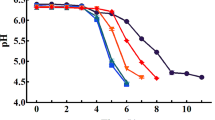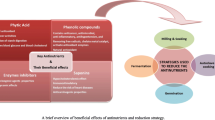Abstract
With an aim of studying the implication of the milling interventions and supplementation of non-wheat grains on the effect of the carbohydrate digestive profile of wheat flour the present study was conducted. Quinoa grain was selected for the study due its higher protein content and better amino acid profile than that of cereal grains. Milling of grains to produce atta (whole wheat flour) was carried out using traditional method of stone chakki mill and the other method of separation and recombination of different stream using roller mill. The atta flour was then supplemented with the quinoa flour in different combinations and the physico-chemical, rheological and product making characteristics were studied. The milling technique has an impact on the damaged starch with the difference of around 6% across the flour samples which further impacted the water absorption capacity and the gelatinization temperature of the flour. Carbohydrate digestive profile of the prepared tortillas have shown significant difference when the atta from roller mill substituted with quinoa flour upto 15%. Starch digestibility index of stone chakki atta was higher SDI (78.71) than that of roller milled quiooa supplemented flours (38.52 and 36.74). The rapidly digestible sugar decreased and the slow digestible sugar increased as compared to stone chakki atta tortillas which combinedly is responsible for lower glycaemic index. In the commercial point of view this will open a new avenue for food manufacturer to produce value added and healthy products from quinoa.




Similar content being viewed by others
Data availability
All data generated or analysed during this study are.
Code availability
Not applicable.
References
AACC (2000) Approved methods of the AACC, 10th edn. American Association of Cereal Chemists, St. Paul, MN
Analysis of AOAC International (AOAC) (2012) in official methods of AOAC, 19th edition
Englyst KN, Englyst HN, Hudson GJ, Cole TJ, Cummings JH (1999) Rapidly available glucose in foods: an in vitro measurement that reflects the glycemic response. Am J Clin Nutr 69(3):448–454
Fleming JE, Galwey NW (1995) Quinoa (Chenopodium quinoa). Cereals and pseudocereals. Chapman and Hall, pp 3–83
Gewehr MF, Danelli D, Melo LMD, Flöres SH, Jong EVD (2017) Nutritional and technological evaluation of bread made with quinoa flakes (Chenopodium quinoa willd). J Food Process Preserv 41(2):e12803
Gorinstein S, Pawelzik E, Delgado-Licon E, Haruenkit R, Weisz M, Trakhtenberg S (2002) Characterisation of pseudocereal and cereal proteins by protein and amino acid analyses. J Sci Food Agric 82:886–891
Hallén E, İbanoğlu Ş, Ainsworth P (2004) Effect of fermented/germinated cowpea flour addition on the rheological and baking properties of wheat flour. J Food Eng 63:177–184
Haridas Rao P, Leelavathi K, Shurpalekar SR (1989) Effect of damaged starch on chapati making quality of whole wheat flour. Cereal Chem 66:329–333
Inamdar AA, Sakhare SD, Prabhasankar P (2015) Chapati making quality of whole wheat flour (Atta) Obtained by various Processing Techniques. J Food Process Preserv 39:3032–3039
Inamdar AA, Prabhasankar P (2017) Influence of stone chakki settings on the characteristics of whole wheat flour (Atta) and its chapati making quality. J Food Process Preserv 41(3):e12966
James LE (2009) Quinoa (Chenopodium quinoa Willd.): composition, chemistry, nutritional, and functional properties. Adv Food Nutrition Res 58:1–31
Jancurová M, Minarovičová L, Dandár A (2009) Rheological properties of doughs with buckwheat and quinoa additives. Chem Papers. 63(6):738–41
Konishi Y, Hirano S, Tsuboi H, Wada M (2004) Distribution of minerals in quinoa (Chenopodium quinoa Willd) seeds. Biosci Biotechnol Biochem 68(1):231–234
Lee D, Hwang W, Artan M, Jeong DE, Lee SJ (2015) Effects of nutritional components on aging. Aging Cell 14:8–16
McWatters KH, Phillips RD, Walker SL, McCullough SE, Mensa-Wilmot Y, Saalia FK, Hung YC, Patterson SP (2004) Baking performance and consumer acceptability of raw and extruded cowpea flour breads. J Food Qual 27(5):337–351
Mousa EI, Ibrahim RH, Shuey WC, Maneval RD (1979) Influence of wheat classes, flour extractions and baking method on Egyptian balady bread. Cereal Chem 56:563–566
Pande S, Sakhare SD, Bhosale MG, Haware DJ, Inamdar AA (2017) Atta (whole wheat flour) with multi-wholegrains: flour characterization, nutritional profiling and evaluation of chapati making quality. J Food Sci Technol 54(11):3451–3458
Parimala KR, Sudha ML (2015) Wheat-based traditional flat breads of India. Crit Rev Food Sci Nutr 55:67–81
Pawar T, Kumar P, Ashwin Kumar P et al (2020) Milling interventions for the production of atta for Indian flat bread with low carbohydrate digestibility. J Food Sci Technol. https://doi.org/10.1007/s13197-020-04373-x
Quail K, McMaster G, Wootton M (1993) Flat bread production. Food Australia: Official Journal of CAFTA and AIFST. 43, 155–157
Repo-Carrasco R, Espinoza C, Jacobsen SE (2003) Nutritional value and use of the Andean crops quinoa (Chenopodium quinoa) andka˜ niwa (Chenopodium pallidicaule). Food Rev Int 19:179–189
Repo-Carrasco-Valencia R, A-M, Serna LA (2011) Quinoa (Chenopodium quinoa, Willd) as a source of dietary fiber and other functional components. Food Sci Tech-Brasil 31:225–223
Ruales J, Nair BM (1994) Properties of starch and dietary fibre in raw and processed quinoa (Chenopodium quinoa, Willd.) seeds. Plant Foods Hum Nutr 45:223–246
Ruales J, Valencia S, Nair B (1993) Effect of Processing on the Physico-Chemical Characteristics of Quinoa Flour (Chenopodium quinoa, Willd). Starch‐Stärke 45(1):13–19
Sakhare SD, Inamdar AA (2014) Indian Atta (whole wheat flour) industry: History and recent trends. Agro Food Industry Hi-Tech 25(1):66–69
Sharma P, Chakkaravarthi A, Singh V, Subramanian R (2008) Grinding characteristics and batter quality of rice in different wet grinding systems. J Food Eng 88:499–506
Stikic R, Glamoclija D, Demin M, Vucelic-Radovic B, Jovanovic Z, Milojkovic-Opsenica D, Jacobsen SE, Milovanovic M (2012) Agronomical and nutritional evaluation of quinoa seeds (Chenopodium quinoa Willd) as an ingredient in bread formulations. J Cereal Sci. 55(2):132–8
Tulse SB, Reshma V, Inamdar AA, Sakhare SD (2014) Studies on multigrain milling and its effects on physical, chemical and rheology characteristics of milled streams. J Cereal Sci 60(2):361–367
Vega-Gálvez A, Miranda M, Vergara J, Uribe E, Puente L et al (2010) Nutrition facts and functional potential of quinoa (Chenopodium quinoa Willd.), an ancient Andean grain: a review. J Sci Food Agric 90:2541–2547
Venkateswara Rao G, Leelavathi K, Haridas Rao P, Shurpalekar SR (1986) Changes in the quality characteristics of chapati during storage. Cereal Chem 63(2):131–135
Funding
Not Applicable.
Author information
Authors and Affiliations
Contributions
AAI contributed to the conceptualisation of the study and original manuscript, RH and AKMS conducted the experiments and statistical analysis, MK did data interpretation, SDS did the table an figure designs, wrote the part of original manuscript draft, and performing critical revision.
Corresponding author
Ethics declarations
Conflict of interest
Authors declare no conflict of interest.
Ethical approval
Not applicable.
Additional information
Publisher’s Note
Springer Nature remains neutral with regard to jurisdictional claims in published maps and institutional affiliations.
Electronic Supplementary Material
Below is the link to the electronic supplementary material.
Rights and permissions
About this article
Cite this article
Deshpande, R.H., Kumar, A., Katare, M. et al. Effect of grinding techniques and supplementation of quinoa on the carbohydrate profile of tortillas. J Food Sci Technol 59, 3600–3608 (2022). https://doi.org/10.1007/s13197-022-05365-9
Revised:
Accepted:
Published:
Issue Date:
DOI: https://doi.org/10.1007/s13197-022-05365-9




